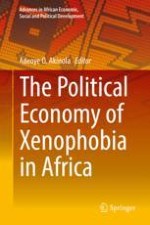2018 | OriginalPaper | Chapter
9. From Hate to Love: Black South Africans and the Xenophobia Project
Authors : Omololu Fagbadebo, Fayth Ruffin
Published in: The Political Economy of Xenophobia in Africa
Publisher: Springer International Publishing
Activate our intelligent search to find suitable subject content or patents.
Select sections of text to find matching patents with Artificial Intelligence. powered by
Select sections of text to find additional relevant content using AI-assisted search. powered by
